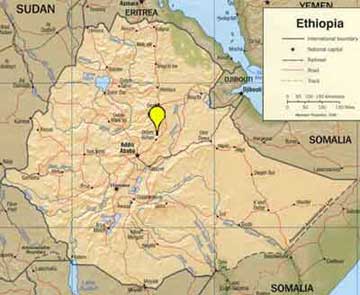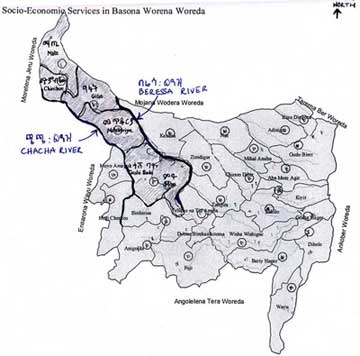Background | |
Geography | |
|
ADHENO activities are focused in the “Woreda” (district) of Bassona Worana in the North Shoa zone, in the north central highlands of Ethiopia. These Ethiopian highlands are part of the Eastern Afromontane, an area designated as biodiversity hotspots by Conservation International. This biodiversity hotspot in Ethiopia is characterized by rugged terrain separated from each other by deep gorges and plateaus. Within Bassona Worana Woreda, ADHENO activities are currently focused in an area that is bounded by the Beressa River to the north and the Chacha River to the south. This area consists of the “kebeles” (neighborhoods) of : Moyi, Goshe Bado, Metkoriya, Gift, Chimbire, and Mati. The region is approximately 147 to 172 km north of the Ethiopian capital, Addis Abeba. |
 |
In general this is a region where human impact has degraded the ecosystem for millennia. Both the human and cattle population have been increasing throughout the history of the region without concomitant improvements in agricultural practices that conserve the ecosystem. This has led to the deterioration of the ecosystem, including decreased fertility of the soil, and falling agricultural yields, which has significantly impacted the livelihood of a population that is almost 100% dependent on the land. As a result, the population has been pushed further and further into poverty. The region has been neglected for decades with minimal investment in infrastructure. |
 Basona Worena Woreda – Detail |
Target Population | |
The project’s target population in the six indicated “kebeles” is about 25,000. Subsistence farming is the primary and in most cases the only source of income for the target population. The per capita gross national income (GNI) in the project region is substantially lower than Ethiopia’s national average of $160 USD*. Local grass roots organizations include the Moyi Farmers Association, the Talak Amba Farmers Association, as well as youth groups that have recently formed such as the “Goshebado Tsigereda Wetatoch Hibret Sira Mehaber” (Goshe Bado Youth Cooperative). ADHENO engages directly with these local groups in implementing various development projects. *source: World Bank Study |
 |
Key Facts | |
Ethiopia is one of the most severely under developed nation in Sub-Sharan Afrcia. Northern (Semen) Shewa was selected as the project site because this region has historically been one of the most deprived and neglected regions in Ethiopia and continues to be so today. Unfortunately, even by Ethiopian standards the region is underdeveloped and government’s statistics (source: CSA, WMS, April 2001) below point to the severity of situation: 1.Public tap is a source of water for only 3.8% of households in Semen (North) Shewa (9.2% for all of Amhara region), as opposed to 11.5% in Oromiya 19.3% in Tigray, 14.5% in Gambella, and 13.5% nationally 2.Enrollment in secondary school is 1.8% in Semen Shewa (7.8% for all of Amhara region), as opposed to 9.1% in Oromiya 17.7% in Tigray, 21.1% in Gambella, and 11.6% nationally 3. Households with access to pit latrine or flush toilet is 1.7% in Semen Shewa (7.0% for all of Amhara region), as opposed to 17.1% in Oromiya 12.7% in Tigray, 28.3% in Gambella, and 18.0% nationally |
|

|
ADHENO - Integrated Rural Development Association |
||||||
